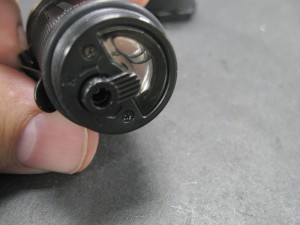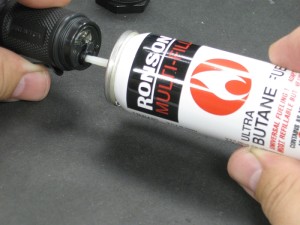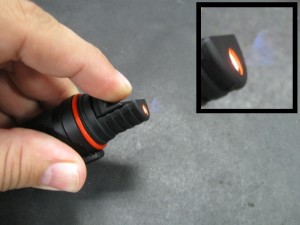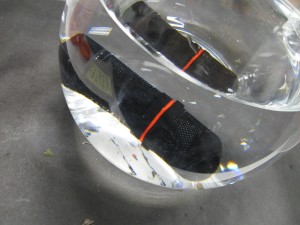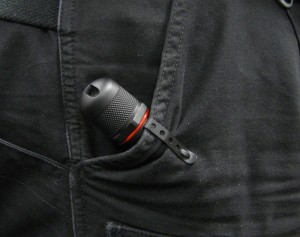Brunton‘s Storm lighter (listed as the “Firestorm” on the Brunton website and in the instructions packaged with it, though the blister pack does indeed call it the “Storm”) is intended as a survival/camping/hiking tool for use in high-winds and around bodies of water. It’s a large cylinder with two screw-on caps, one covering the butane reservoir and one covering the piezo-electric lighting element. Provided the O-rings between those caps remain intact, the lighter is waterproof (to a presumably relatively shallow depth). It comes complete with a pocket clip. There is also a lanyard hole in the cap. The body and cap are nicely knurled and provide good traction.
The lighter’s official specifications, according to Brunton’s website, are as follows:
Size: 1.88
inches
Weight: 1.6
ounces (unfilled)
Windproof:
To 80 mph
Ignitions: 30,000
Warranty:
One year
Brunton describes the lighter as “sleek and sexy,” as well as “one tough lighter.” It’s definitely marketed as survival gear, and is priced accordingly. The idea is that in adverse conditions, while you could carry a simple disposable butane lighter, a lighter of this type will be more reliable in high winds — and if you accidentally fall into a river.
Out of the package, the lighter presented me with my first task: filling it. If you’ve never filled a refillable butane lighter, you should know this is a huge pain in the ass. This is not the Brunton’s fault; it’s just a function of trying to get butane fuel from a pressurized container into the lighter’s fill hole. If you’re not careful, butane under pressure will spray all over the place, which has a cooling effect. If you make the lighter too cold, you could even damage the plastic butane reservoir. It will crack if it gets cold enough, rendering the
lighter completely useless.
To solve this problem, I enlisted the help of a coworker who is a former smoker. He has filled many a butane lighter and showed me the knack of doing it, holding the lighter sideways or even upside-down. We fueled the Brunton in spurts to avoid the risk of cold-induced damage. When we were done, the reservoir was visibly filled with butane, as you can see in the picture above.
The piezoelectric lighting element glows red when it ignites. It takes a few clicks of the switch to “warm up” the action before the lighter will do its thing, but once you get it going it lights reliably. You have to allow enough butane to escape so that you have something to light, of course, so a typical lighting procedure is a few fast clicks of the switch, followed by a slow push-and-click to ignite the escaping gas. The result is as you see below — an almost invisible inverted cone of super-hot flame that is resistant to high wind.
To test the lighter’s water- and wind-resistant properties, I first dunked the lighter in a pitcher of water and left it there for about five minutes. The O-rings are the only thing keeping water from seeping into the action when the lighter is sealed up, so you’ll want to check these periodically and make sure they remain undamaged.
After a thorough dousing, the lighter did indeed work just fine once I retreived it and uncapped it. I then used a very large industrial-strength fan to simulate wind. With the fan going (you can see this test performed in the YouTube video embedded on this page), I was able to light the Brunton and then effectively burn the end of some frayed paracord. The simulated wind made the flame dance around a little bit, but it worked fine.
As you can see, the lighter rides relatively high in the pocket, leaving the cap exposed. For hiking I think I would much rather tie a lanyard to the lighter than use the clip, but as a daily carry item (if that’s your thing), the clip should serve you just fine.
In daily use, two caveats apply: If you’re operating at high altitudes, the lighter will activate less reliably than it does closer to sea level. (This is just a fact of physics and is disclaimed in Brunton’s marketing literature.) Second, you cannot allow the lighter to freeze. If you are out in below-freezing temperatures, you must carry the lighter close to your body to keep its temperature above freezing to protect it from damage. This is a limitation of butane lighters.
For a lot of people who don’t spend time outdoors or in harsh environments, this will be more lighter than they need (and at a higher price than they want to pay). For those who want a dedicated “survival” lighter, however, especially one that is resistant to wind and exposure to moisture, the Brunton would make a good choice.

